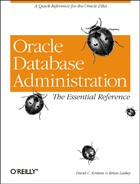Disk Layout
The more independent physical disks that can be dedicated to Oracle files, the better the I/O operation of the system is likely to be. Carefully planning the location of each Oracle file will yield significant improvements in the performance of the database. Use the following guidelines when laying out the disk subsystem:
Allocate separate disks for data, redo logs, and archive files.
Keep data and index segments for a given table in separate tablespaces, on separate disks.
Use a separate disk for rollback segments.
Keep the system tablespace on a separate disk or on a lightly used disk.
Try to keep Oracle files on different disks from user filesystems.
An ideal disk layout might look like the layout shown in Table 11.2.
|
Disk |
Contents |
|
01 Controller A |
Oracle software ($ORACLE_HOME ), control file 1 |
|
02 Controller A |
SYSTEM tablespace |
|
03 Controller A |
DATA tablespace |
|
04 Controller A |
Redo log group 1, member 1 Redo log group 3, member 1 |
|
05 Controller A |
Redo log group 2, member 1 Redo log group 4, member 1 |
|
06 Controller A |
Redo log group 1, member 2 Redo log group 3, member 2 |
|
07 Controller A |
Redo log group 2, member 2 Redo log group 4, member 2 |
|
08 Controller B |
TOOLS tablespace |
|
09 Controller B |
TEMP tablespace, control file 2 |
|
10 Controller B |
ROLLBACK tablespace |
|
11 Controller B |
INDEX tablespace |
|
12 Controller B |
Archivelog destination |
|
13 Controller B |
Application software |
|
14 Controller B |
User files, exports, etc. |
Since this system has two controllers, we have made the following decisions:
Locate the INDEX tablespace on a different controller from the DATA tablespace.
Rationale: During inserts and updates, there will be heavy activity as rows are inserted and indexes are updated. Distributing I/O across two controllers provides more I/O bandwidth.
Locate the ROLLBACK tablespace on a different controller from the DATA tablespace.
Rationale: During heavy inserts and updates, there will be a significant number of rollback records written, so placing the ROLLBACK tablespace on a separate controller improves I/O bandwidth.
Allocate two members for each log group.
Rationale: This protects against the loss of a log file by providing Oracle log file mirroring.
Alternate the locations of each log group across two different disks.
Rationale: While one log file is being archived, the next file can be written to without I/O contention.
Locate the archive log destination on a different controller from the online log files.
Rationale: When running in archivelog mode, the ARCH process can read the online log file from one controller while writing to the archive log destination with the other controller.
